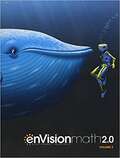- Table View
- List View
enVision® Mathematics, Grade 3, Volume 2, Topics 8-16, Teacher's Resource Masters
by Savvas Learning CompanyNIMAC-sourced textbook
enVision® Mathematics, Grade 5, Additional Practice Workbook: Topics 1-16
by Scott ForesmanNIMAC-sourced textbook <p>Grade 5</p>
enVision® Mathematics, Tennessee, Grade 5, Student Companion
by Randall I. Charles Jennifer Bay-Williams Robert Q. Berry IIINIMAC-sourced textbook
enVision® Mathematics, Tennessee, Grade K, Student Companion
by Randall I. Charles Jennifer Bay-Williams Robert Q. Berry IIINIMAC-sourced textbook
envisionMATH® 2.0 Topics 9-16: Volume 2
by Scott Foresman - Addison WesleyDaily Problem-based Interactive Learning followed by Visual Learning strategies deepen conceptual understanding by making meaningful connections for students and delivering strong, sequential visual/verbal connections through the Visual Learning Bridge in every lesson. Ongoing Diagnosis and Intervention and daily Data-Driven Differentiation ensure that enVisionMATH gives every student the opportunity to succeed.
geni@l klick: German Textbook Level 1
by Ute Koithan Theo Scherling Michael Koenig Yo Rühmer Barbara WelzelNIMAC-sourced textbook
i-Ready Classroom Mathematics: Volume 1
by Curriculum Associates Llc.NIMAC-sourced textbook <p>Grade 7
i-Ready Classroom Mathematics: Volume 1
by Curriculum Associates Llc.NIMAC-sourced textbook <p>Grade 8
i-Ready Classroom Mathematics: Volume 1
by Curriculum Associates Llc.NIMAC-sourced textbook <p>Grade 6
i-Ready Classroom Mathematics: Volume 2
by Curriculum Associates Llc.NIMAC-sourced textbook <p>Grade 7
i-Ready Classroom Mathematics: Volume 2
by Curriculum Associates Llc.NIMAC-sourced textbook <p>Grade 2
i-Ready Classroom Mathematics: Volume 2
by Curriculum Associates Llc.NIMAC-sourced textbook <p>Grade 8
i-Ready Classroom, Grade 4, Mathematics, Volume 1
by Curriculum Associates, LLC., Curriculum Associates, LLC.NIMAC-sourced textbook
i-Ready Classroom, Grade 4, Mathematics, Volume 2
by Curriculum Associates Llc.NIMAC-sourced textbook
i-Ready Classroom, Grade 5, Mathematics, Volume 2
by Curriculum Associates Llc.NIMAC-sourced textbook
i-Ready Classroom, Grade 6 Mathematics, Volume 2
by Curriculum AssociatesNIMAC-sourced textbook <p>Grade 6</p>
i-Ready Classroom, Grade 6, Mathematics, Volume 1
by Curriculum Associates Llc.NIMAC-sourced textbook
i-Ready Classroom, Grade 6, Mathematics, Volume 2
by Curriculum Associates Llc.NIMAC-sourced textbook
i-Ready Classroom, Mathematics: Grade 1, Volume 1 (i-Ready Classroom)
by Curriculum AssociatesNIMAC-sourced textbook
i-Ready Classroom, Mathematics: Grade 1, Volume 2 (i-Ready Classroom)
by Curriculum AssociatesNIMAC-sourced textbook <p>Grade 2</p>

